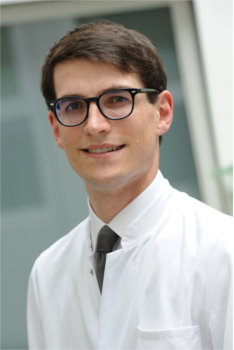Dr. med. Fabian Westhauser
Dr. med. Fabian Westhauser
Center for Orthopedics, Traumatology, and Spinal Cord Injury.
Heidelberg University Hospital.
Schlierbacher Landstraße 200a
69118 Heidelberg
e-mail: fabian.westhauser@med.uni-heidelberg.de
Clinical bone defect treatment creates a need for biocompatible, osteoconductive and bioactive bone substitutes. The optimization of the materials used is currently in the spotlight of modern orthopedic research. However, the well-used standard ceramic materials are limited in their osteostimulative capabilities, making innovative materials such as bioactive glasses (BG) a serious alternative. Though, there is still room for improvement of BG, especially concerning structural properties such as surface characteristics or porosity [1]. By using standardized in-vitro and in-vivo models in combination with the most recent technical innovations, the group of Dr. Westhauser evaluates the osteogenic properties of different bone substitutes [2]. The current projects focus on the evaluation of differently structured bioactive glasses, the evaluation of different glass compositions, the combination of ceramics and bioactive glasses, and the incorporation of growth and differentiation factors in biomaterials. In the context of these research projects, the collaboration with the FAU Institute of Biomaterials involves testing a series of BG based 3D scaffolds designed for bone tissue engineering.
[1] F. Westhauser, C. Weis, M. Prokscha, L.A. Bittrich, W. Li, K. Xiao, U. Kneser, H.U. Kauczor, G. Schmidmaier, A.R. Boccaccini, A. Moghaddam, Three-dimensional polymer coated 45S5-type bioactive glass scaffolds seeded with human mesenchymal stem cells show bone formation in vivo, J Mater Sci Mater Med 27(7) (2016) 119.
[2] F. Westhauser, C. Weis, M. Hoellig, T. Swing, G. Schmidmaier, M.A. Weber, W. Stiller, H.U. Kauczor, A. Moghaddam, Heidelberg-mCT-Analyzer: a novel method for standardized microcomputed-tomography-guided evaluation of scaffold properties in bone and tissue research, R Soc Open Sci 2(11) (2015) 150496.

